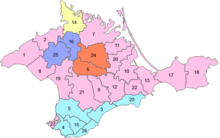Crimea Germans
In 1939, two years before their deportation to Central Asia, around 60,000 of the 1.1 million inhabitants of Crimea were German and "they had their own administrative raion in the Crimean Republic.".
[2][citation needed] In late 1941, following the Axis invasion of the western regions of the USSR, Soviet authorities forcibly removed almost 53,000 native Germans of Crimea eastwards to Siberia and Central Asia on entirely spurious allegations that they were spies for the Third Reich.
He considered them all potential traitors, and in line with his inherent "Great Russian" chauvinism, had already decided to deport the entire community to internal exile in case of war.
Although the decree stated that old people would not have to leave, everyone was expelled—first to Stavropol, and then Rostov in Southern Ukraine, near Crimea; but then all were sent on to forced labor camps and special settlements in Kazakhstan, Central Asia.
"[3]It is unclear whether any Crimea Germans remained at all during the Nazi occupation—German policy called for the evacuation of all surviving Soviet Volksdeutsche to settlements in Poland.
[6] The Nazi Generalkommissar for Crimea, the Austrian Alfred Frauenfeld, toyed with the idea of resettling ethnic Germans (Volksdeutsche) here from Italian South Tyrol after the war, and he re-labelled several cities of the envisaged Gotengau with spurious German/Gothic names: (Simferopol became Gotenburg and Sevastopol became Theoderichshafen, for example, honoring the Goths and the Gothic king Theodoric).
("On the Measures for the Rehabilitation of Armenian, Bulgarian, Greek, Crimean Tatar and German Peoples and the State Support of Their Revival and Development"),[10] amended by Decree no.


